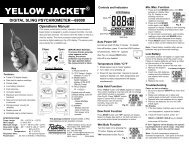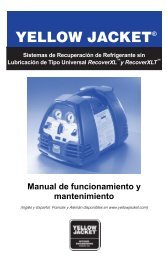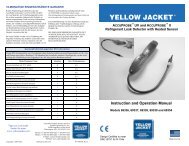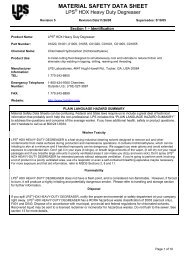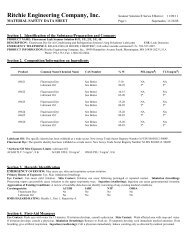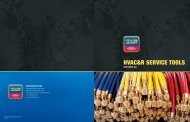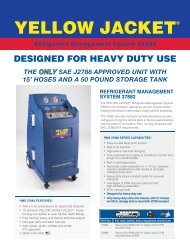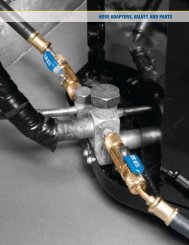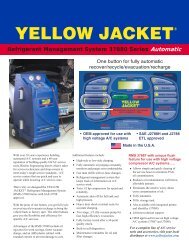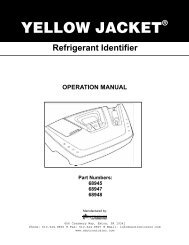What You Need to Know When Recovering R-410A - Yellow Jacket
What You Need to Know When Recovering R-410A - Yellow Jacket
What You Need to Know When Recovering R-410A - Yellow Jacket
You also want an ePaper? Increase the reach of your titles
YUMPU automatically turns print PDFs into web optimized ePapers that Google loves.
YELLOWJACKET ®VOLUME 1, ISSUE 3UPDATEArticle reprinted withpermission from RSES JournalAugust 2003The high pressures involved with recoveringR-<strong>410A</strong> refrigerant requires using the properequipment <strong>to</strong> avoid serious injuryBY RALPH VERGARAThe U.S. Clean Air Act of 1990 and the MontrealPro<strong>to</strong>col call for the phaseout of HCFC-22 (commonlyknown as R-22). This has made it necessaryfor manufacturers <strong>to</strong> find a replacement for the standardR-22 refrigerant we all know so well.The replacements available <strong>to</strong>day are HFCs R-407C orR-<strong>410A</strong>. Whether you work with R-<strong>410A</strong> or not, chancesare that most service technicians will work with it in thefuture.Since Carrier first introduced newly designed systemscharged with its version of R-<strong>410A</strong> called Puron in 1996,the industry has rapidly moved <strong>to</strong>ward the use of therefrigerant. It is important <strong>to</strong> note that R-407C also iswidely accepted as a retrofit refrigerant for new designs,though it is used more frequently in Europe than inNorth America. It also is important <strong>to</strong> note that R-<strong>410A</strong>is not <strong>to</strong> be used in retrofit applications.Many manufacturers of residential and commercialhvac systems are switching <strong>to</strong> or currently use R-<strong>410A</strong> intheir systems. The refrigerant is an HFC azeotropic mixtureof HFC-32 and HFC-125 and is now universallyaccepted in the hvacr industry. One more note is that theCopeland scroll compressor is the only compressordesigned <strong>to</strong> be used with R-<strong>410A</strong>.Safety firstBefore discussing the R-<strong>410A</strong> recovery process it is important<strong>to</strong> address safety. The major difference between R-22and R-<strong>410A</strong> is the significantly higher pressures involvedwith using R-<strong>410A</strong>. Working with R-<strong>410A</strong> requires someadditional <strong>to</strong>ols that you may not already have in yourservice vehicle.The pressure-temperature chart for R-<strong>410A</strong> comparesthe pressures of R-<strong>410A</strong> versus R-22 (see chart on the nextpage). This chart will show you how high the pressuresare that you will be working with. In general, R-<strong>410A</strong>pressures are 1.8 times higher than those of R-22.<strong>You</strong>r standard manifold set, hoses, recovery equipmentand recovery cylinder cannot be used when recoveringR-<strong>410A</strong>. The pressures you will see when working withAugust 2003 ~ RSES Journal
R-<strong>410A</strong> are <strong>to</strong>o high for your standard equipment.Here are the items a technician will need <strong>to</strong> safelywork with R-<strong>410A</strong>.• Manifold set. The pressures encountered whileworking with R-<strong>410A</strong> require a manifold gauge set thathas a low-side gauge that reads up <strong>to</strong> 500 psig and a highsidegauge that reads up <strong>to</strong> 800 psig. This is higher thanyour standard manifold set.• Hoses. R-<strong>410A</strong> hoses and assemblies should be ULrecognizedand have a minimum of 800-psi working pressureand a 4,000-psi burst. This provides a five-<strong>to</strong>-onesafety fac<strong>to</strong>r.Temperature °FPressure PressureR-22 (psi) R-<strong>410A</strong> (psi)70 121.5 201.575 132.2 218.280 143.7 235.985 155.7 254.690 168.4 274.395 181.9 295.0100 196.0 316.9105 210.8 339.9110 226.4 364.1115 242.8 389.6120 260.0 416.4125 278.1 444.5130 297.0 474.0135 316.7 505.0140 337.4 537.0145 359.1 571.7150 381.7 607.6155 405.4 645.2Manufacturers also recommend that you use a ballvalve-typeconnection rather than an anti-blowback connec<strong>to</strong>r.An anti-blowback connec<strong>to</strong>r acts like a check valveand traps the refrigerant in the hose. This can make itdifficult <strong>to</strong> disconnect the hose under high-pressure conditions.A ball valve connec<strong>to</strong>r is much easier <strong>to</strong> controlunder high-pressure conditions.Although most R-<strong>410A</strong> units come with the standard1/4-inch fittings some manufacturers use 5 /16-inch accessfittings.<strong>When</strong> buying new hoses make sure that you buy acomplete hose assembly that has been recognized byUnderwriters Labora<strong>to</strong>ries. Some hose manufacturers useUL-recognized hose but fail <strong>to</strong> have the complete assemblycertified for R-<strong>410A</strong> pressures.• Recovery equipment. Refrigerant recovery equipmentneeds <strong>to</strong> be R-<strong>410A</strong> compatible. To determine if yourexisting unit is approved, check the Air-Conditioning andSpecial equipmentis neededwhen recoveringR-<strong>410A</strong> <strong>to</strong> accommodatethe highpressures involved.Refrigeration Institute’s (ARI) website at www.ari.org orthe UL website at www.ul.com.Recovery units must be approved for Class V refrigerantsincluding R-407C, R-404A and R-507 and others perARI 740-98. For best performance with your R-<strong>410A</strong>recovery equipment, it should have the following features:oversized condenser; oversized fan; crankcase pressureregula<strong>to</strong>r (CPR) valve; and a high-pressure cu<strong>to</strong>ut switchrated for at least 510 psi.Recovery equipment also is available with a subcoolingfeature, which can be helpful when trying <strong>to</strong> recoverR-<strong>410A</strong>. Subcooling keeps the recovery tank pressuredown by ensuring that the refrigerant is fully condensedbefore putting it in<strong>to</strong> the recovery cylinder. Keepingrecovery tank pressures down will increase the rate ofrecovery and reduce the wear and tear on recovery equipment.Subcooling also can be accomplished by submergingthe recovery cylinder in a bucket of ice.• Oversized condenser. Helps completely condensethe refrigerant and <strong>to</strong> keep the tank temperatures down.• Fan. The larger the fan and the more aggressive theSubcooling, whichkeeps recoverytank pressuredown by ensuringthat refrigerant isfully condensedbefore putting itin<strong>to</strong> the recoverycylinder, can beaccomplished bysubmerging thecylinder in abucket of ice.RSES Journal ~ August 2003
The push-pull recovery method works best when recovering more than 10 poundsof refrigerant.Liquid recovery is fast, but not all equipment can handle the process. Vapor recoveryis slower, but is the most common recovery method used.pitch of the blades, the more air is moved over the condenser.More airflow also keeps critical internal componentscool, increasing their life expectancy.• Crankcase pressure regula<strong>to</strong>r (CPR). This devicewill ensure that you do not overwhelmthe recovery equipmentwith high pressures when workingwith R-<strong>410A</strong>. Units that use a CPRvalve do not require the technician<strong>to</strong> throttle or regulate the flow ofrefrigerant <strong>to</strong> the recovery unit <strong>to</strong>prevent damage <strong>to</strong> the compressor.• Recovery cylinders. <strong>You</strong>must use a U.S. DOT 400 recoverycylinder when recovering R-<strong>410A</strong>.As mentioned above, a standardDOT 350 recovery cylinder will notsafely handle the high pressuresseen with R-<strong>410A</strong>. <strong>You</strong>r R-<strong>410A</strong>recovery cylinders should be clearlymarked <strong>to</strong> prevent any chance ofmisuse. DOT 400 tanks should bereadily available at your localrefrigeration wholesaler.• High-pressure cu<strong>to</strong>ut. Ahigh-pressure switch rating higherthan 510 psi will keep the recoveryunit from prematurely relieving onhigh pressure when recoveringR-<strong>410A</strong>. Some manufacturers offerequipment with an override switchso that you can change over <strong>to</strong> ahigher-pressure switch when recoveringR-<strong>410A</strong>.The problem with having a dualswitch (550 or higher) is that anR-<strong>410A</strong> recovery cylinder (DOT400) and a standard recoverycylinder (DOT 350) are virtuallyindistinguishable. Using recoveryequipment with a high-pressureswitch rated at 550 with a standardDOT 350 recovery cylindercan cause the relief valve <strong>to</strong> blow.This can cause a dangerous situationfor you or your cus<strong>to</strong>mers.Proper maintenance of thesepieces of equipment is critical foryour safety. Calibrate the gauges onyour manifold set before every useand annually check manifold setfor leakage. Check for nicks orcracks in your hoses. Make surethat the valve assemblies are notleaking and that the gaskets in yourhoses are in good shape.Check your recovery unit periodically <strong>to</strong> ensure that itis safe <strong>to</strong> use. If you notice degradation in the rate ofrecovery, check the built-in or external filter. Clearly markAugust 2003 ~ RSES Journal
all of your R-<strong>410A</strong> tanks and have them re-certified everyfive years.Recovery methodsOnce acquiring the proper equipment, it is time <strong>to</strong> getstarted with the recovery process. Although refrigerantproperties are different, the basic recovery process is thesame for R-<strong>410A</strong> and R-22.R-<strong>410A</strong> is much more dense than R-22 and has a highervapor pressure making it more difficult <strong>to</strong> recover. <strong>You</strong>must understand that the information in this article doesnot apply <strong>to</strong> all refrigerant recoveryequipment. The hook-up and recoveryinstructions will vary from manufacturer<strong>to</strong> manufacturer so be sure <strong>to</strong>read and understand all of the operationinstructions for your refrigerantrecovery unit.Although refrigerantproperties aredifferent, the basicrecovery processis the same forR-<strong>410A</strong> and R-22recovering R-<strong>410A</strong> refrigerant:• Always use the shortest hoses possible.• Using 3 /8-inch hose will greatly increase yourrecovery rates.• Use a heat gun <strong>to</strong> get refrigerant <strong>to</strong> boil off.• Use liquid recovery when possible.◆Ralph Vergara is the technical sales manager for RitchieEngineering. He engineers and designs commercial recoveryequipment and au<strong>to</strong>motive refrigerant recovery, recyclingand recharging equipment for Ritchie.Click <strong>to</strong> all the <strong>to</strong>ols you’ll ever need...www.yellowjacket.comAccept nothing less.New MicroLED UV LeakDetec<strong>to</strong>r pinpointsleaks at the speedof light.NewAccuProbe LeakDetec<strong>to</strong>r displays1 through 9 <strong>to</strong> zero-in onall refrigerants. Numberincreases closer youget <strong>to</strong> leak source.Which recovery method should youuse? Here are a few <strong>to</strong> choose from.• Push-pull recovery. Quicklyremoves the liquid refrigerant, but youmust change the hose connections <strong>to</strong>recover the vapor refrigerant after all ofthe liquid is removed. This method isnot recommended unless you are trying<strong>to</strong> recover more than 10 pounds ofrefrigerant.• Liquid recovery. This is thefastest method of refrigerant recovery.However, not all recovery equipment iscapable of handling direct liquidrecovery. Check with the manufacturerof your recovery equipment <strong>to</strong> find outif your unit is capable of direct liquidrecovery and if there are any specialinstructions for direct liquid recovery.• Vapor recovery. This method isslower than liquid recovery, yet is themost common method used <strong>to</strong> recoverrefrigerant.Here are a few tips <strong>to</strong> follow whenNewDigital ElectronicCharging Scale foraccurate chargingwith anyrefrigerant.New DigitalLCD Vacuum Gaugedisplays atmosphere <strong>to</strong>25 microns so youknow systemis clean.Complete catalog and new productsnow on line, or call 952-943-1333.© 2003 Ritchie Engineering Company, Inc.Printed in U. S. A. CP-09/03NewPis<strong>to</strong>l-GripInfrared Thermometerwith laser sightingmeasures -40°F<strong>to</strong> 932°F.www.yellowjacket.com10950 Hampshire Avenue S.Blooming<strong>to</strong>n, MN 55438-2623 USAPhone: 952-943-1333 • Fax: 800-322-8684Int’l Fax: 952-943-1605Reprinted from RSES Journal ~ August 2003



